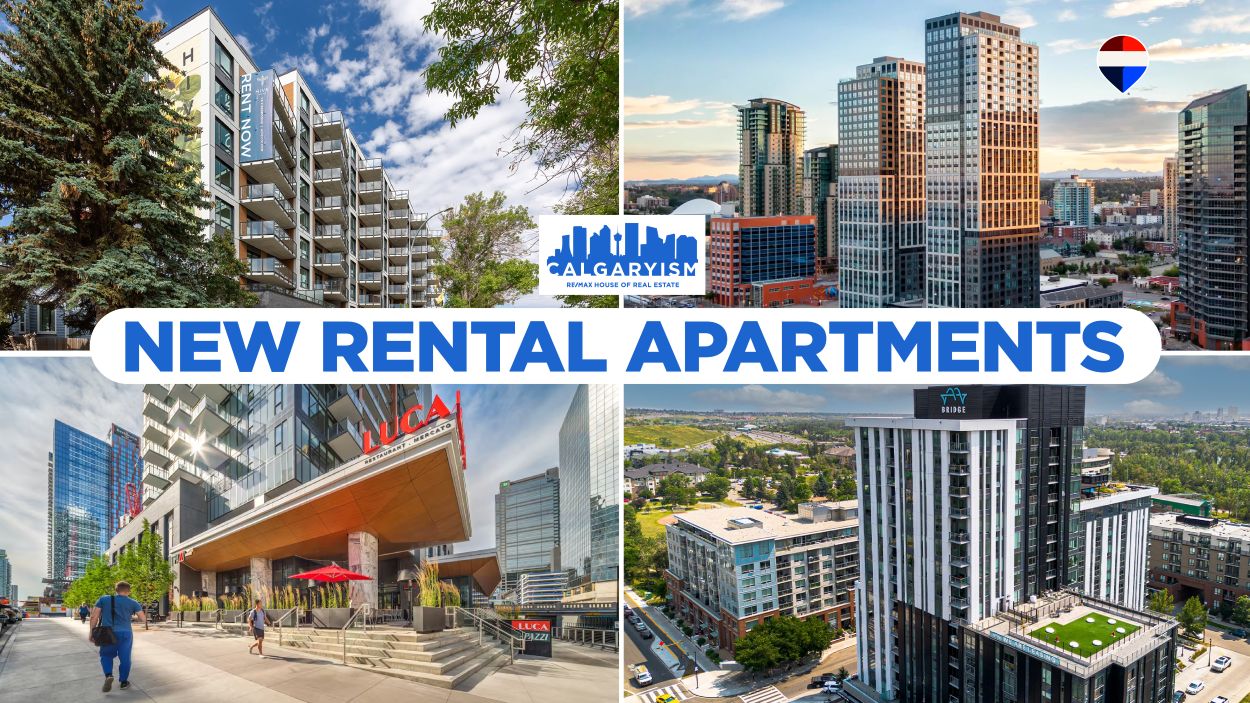Main Content
Suburban vs. Urban Living: Pros and Cons
Suburban vs. Urban Living: Top 20 Advantages & Disadvantages
Urban and suburban areas are two distinct living environments offering different lifestyles, amenities, and characteristics. Understanding the definitions and differences between suburban vs. urban living can help individuals make informed decisions about where to live, work, and invest.
What is Considered an Urban Area?
An urban area is a densely populated region typically located in the heart of a city or metropolitan area. In Calgary, Alberta, an example of a suburban area would be any neighbourhood in the City Centre District, where you’ll find the most established infill communities. Urban areas are characterized by higher population density and more developed infrastructure, typically a mix of commercial and residential — or, if you’re in the heart of downtown Calgary’s business core, for example, almost strictly commercial high-rise towers.
Central communities often have a vibrant and dynamic atmosphere and a wide range of amenities, services, and cultural activities such as festivals because they have the infrastructure to do so. They are also typically hubs for business, commerce, and entertainment, served by extensive public transportation networks. This makes them ideal for those who thrive on the hustle and bustle of city life and prefer having everything they need within close proximity to home.
What is Considered a Suburban Area?
A suburban area is a region located on the outskirts of a city or metropolitan area. In Calgary, Alberta, an example of a suburban area would be the community of Rockland Park or Mahogany lake neighbourhood, both near the brim of the city and well outside the “City Centre” District. Suburban areas are typically less densely populated than urban areas and often have a much larger share of residential development versus commercial or retail.
Suburban homeowners typically enjoy a more relaxed atmosphere and family-friendly environment than their urban counterparts. Suburban areas may have fewer amenities and services, but they often offer larger lots, more space to live, and a lower cost of living due to lower prices. This makes them appealing to families and individuals who value a quieter, more spacious living environment while still being within reach of what the big city has to offer.
Key Takeaways: Urban vs Suburban Living
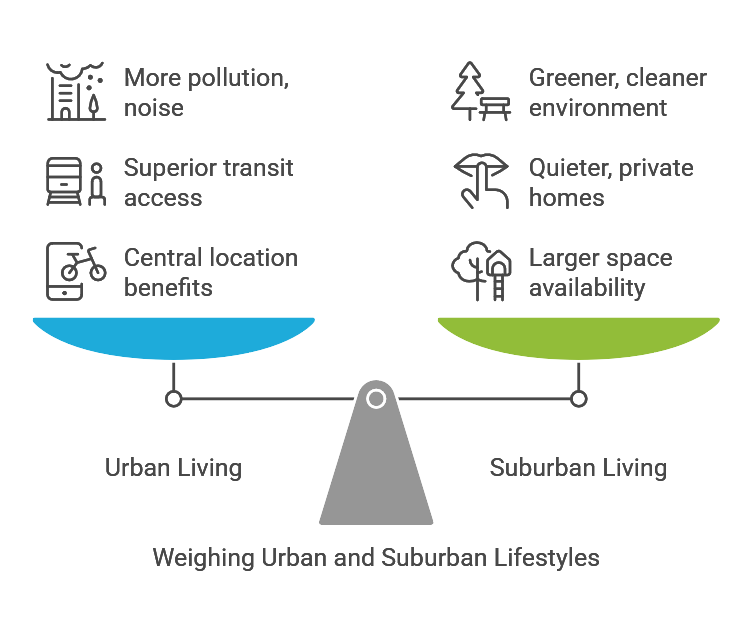
- Location – Central areas offer immediate access to the city’s best entertainment, dining, and cultural attractions.
- Space – Suburban properties provide larger homes and yards for families and outdoor activities.
- Cost – Suburban homes typically offer more square footage for your money, or a lower cost per square foot vs. urban properties.
- Transportation – Urban areas feature superior public transit access and the opportunity to live a walkable lifestyle.
- Privacy – Suburban neighbourhoods typically deliver quieter surroundings and less population density.
- Environment – Urban areas can experience more noise, while suburban areas offer more green spaces.
The age-old question remains when a move is on the horizon: what urban or suburban area of the city should I buy a property in? The downtown area, a bit further out in the inner city, or perhaps a suburban location would be best?
For starters, suburban communities typically have larger houses on bigger lots, and on a comparative basis, cost less than their urban counterparts. Some would also argue that the quality of life is better in a suburban community in terms of family orientation and leisure and recreational opportunities, among other attributes that are hard to deny.
On the other hand, many people say the inner city and downtown are the best places to live. While properties are more costly, the money saved from having to commute from a suburban neighbourhood to work in downtown and back again is well worth it for those who frequent the area, not to mention the full spectrum of amenities and the walkable lifestyle that goes hand-in-hand with living in a central location.
It’s up to you to decide where you want to live. You might be set on a specific neighbourhood for various reasons, while others could still be on the fence. If you are still undecided, check out our pros and cons of suburban and urban living below.
Top 5 Pros of Suburban Living
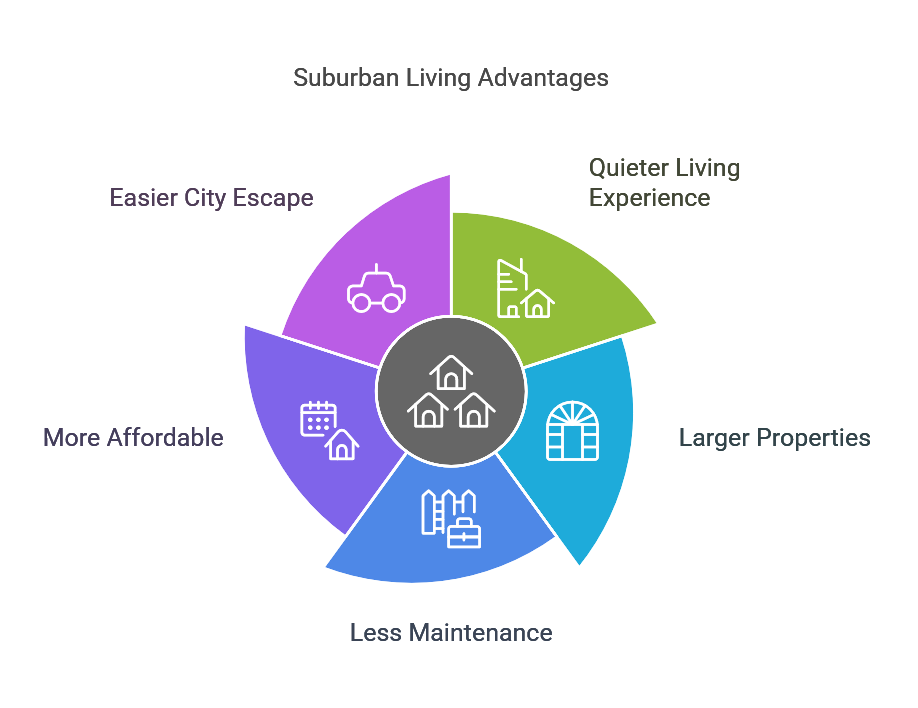
#1 – Quieter, safer living experience
Living in a suburban area typically offers a serene and peaceful living experience compared to the hustle and bustle of a city center. These neighbourhoods can be an ultimate refuge after a busy day in the downtown area and as an escape from the urban white noise of any city centre and its jam-packed streets. They can also be much safer when comparing crime statistics to central city areas.
Additionally, because they are typically situated further away from main city throughways, you won’t hear as much white noise from the city as you would living in an inner city area.
#2 – Larger properties, larger homes
There is typically more living space and larger properties in suburbia across the board. Many families look for a large yard space to accommodate a family friendly environment that includes outdoor activities such as sports or playing a good ol’ game of catch.
Suburban yards definitely have more than enough space for the kid’s trampoline, and that home-grown garden you’ve always wanted, well, there’s room for that too!
#3 – New homes typically have less maintance
Suburban communities, like Auburn Bay in Calgary for example, are newer construction than most of the homes found in the inner city and downtown areas (except for new infill and multi-family developments, of course.
Assuming a home is built correctly by a quality builder, there should be relatively less home maintenance and costs associated with such over the next decade than older construction in the inner city.
#4 – Comparatively, suburban homes are more affordable
Suburban properties are almost always more affordable compared to similar properties in the inner city and cost less per-square-foot basis, giving you more bang for your buck. This is a huge consideration for buyers with affordability at the top of mind.
Choosing to buy a condo in the suburbs, for example, versus in downtown could be the difference between getting those much-wanted work out and office rooms you’ve always wanted and a third bedroom for your family to grow into.
#5 – Leave the city with relative ease
Living in a suburban area with less population density typically means you can escape the city with relative ease versus living in the City Centre. You’ll have access to highways and main routes that are further out from the central hustle and bustle, allowing you to skip the traffic if, let’s say, you’re planning on an outdoor excursion over the weekend.
Having more space in general to live, work, and travel to parts of outside the city is especially valuable for outdoor leisure and recreation enthusiasts to enjoy spending time in natural environments.
Top 5 Cons of Suburban Living
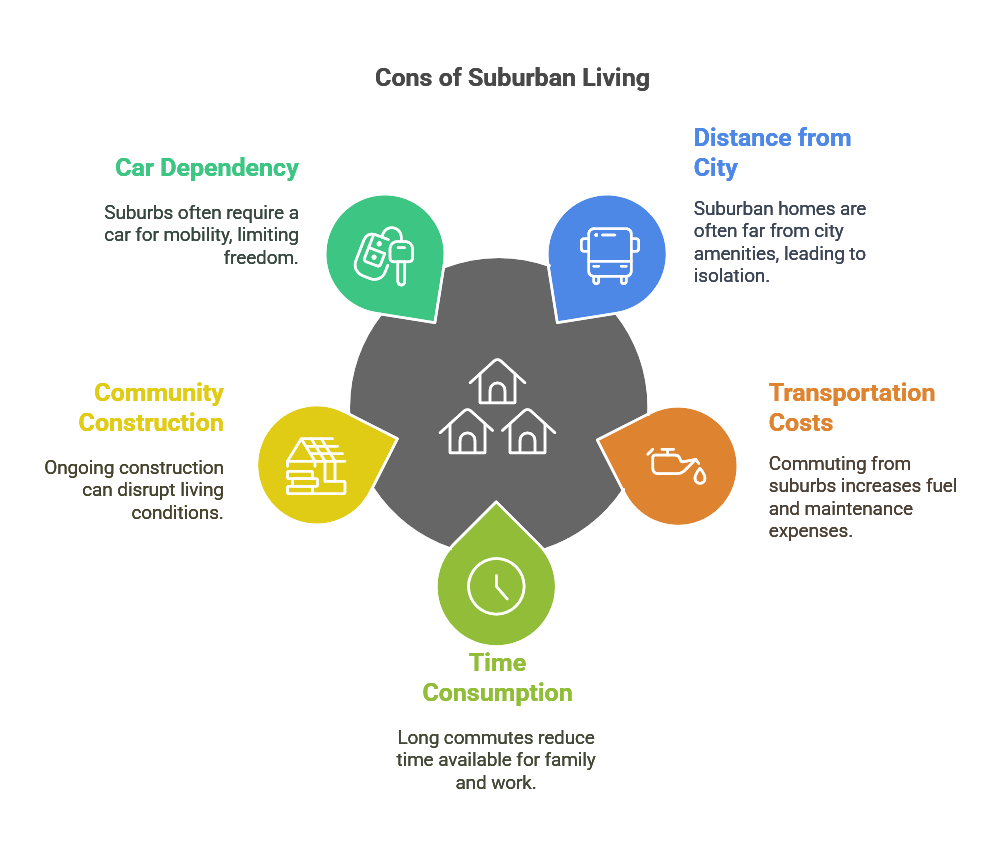
#1 – Far from the city’s best destinations
Most of the best that any city has to offer when it comes to restaurants, entertainment, and nightlife is often found in the inner city and downtown areas. Hence, living in a suburban community might make you feel somewhat isolated from where all the action is, especially if you don’t have a driver’s license or vehicle to use.
When living in the suburbs, a trip to or from your city’s central urban areas might feel like an excursion that requires time, effort and energy — and, in some cases, more money spent.
#2 – Increased transportation costs
Transportation is time is money. So, the longer commuting times you have from your home in suburbia means higher costs for fuel, automobile repairs and service, while the lost time between home and “destination A” could be spent doing more productive or valuable things in life.
Having to travel 45 to 60 minutes to work and back home again could very well mean less time spent with your family, or less time spent at the office as you push to get that new job promotion or year-end bonus.
#3 – Missing out on precious time
We can’t say this enough: time is precious, especially if you have a family you need to take care of. If you will have a longer commute to urban city areas while living in a suburban home, be prepared to spend lots of time driving to and from your community.
Many cities in Canada and across North America are also experiencing rapid population growth, making traffic a bit more staggering than in the past. This adds to the domino effect of more traffic that takes away opportunities to do more essential things like investing time in your work or hanging out with loved ones.
#4 – New and potentially disruptive community construction
A “waiting” factor can be involved when buying a home in suburban or rural communities. If the area is new, or there are many construction projects in the area, it could take months, even years for them to finish.
Hence, buying a new home also comes with its own pros and cons. Make sure to be prepared for mild to severely disruptive new home construction activities if you’re looking to purchase in a neighbourhood that is under development.
#5 – You need a car to get almost anywhere
Unlike in Europe, cities across Canada are often sprawling metropolises that don’t have very great public transportation options. With more space to travel comes a very important consideration: if you don’t have a vehicle, how will you conveniently get from point A to B if you live in suburban or rural communities, especially for work, or another important regular activity or event?
Hence, a careful consideration for suburban vs. urban living is having a car. If you don’t have one, you might find it challenging to go anywhere — especially if you live in a larger city where public transportation isn’t always the best or most efficient way of travel.
Top 5 Pros of Urban Living
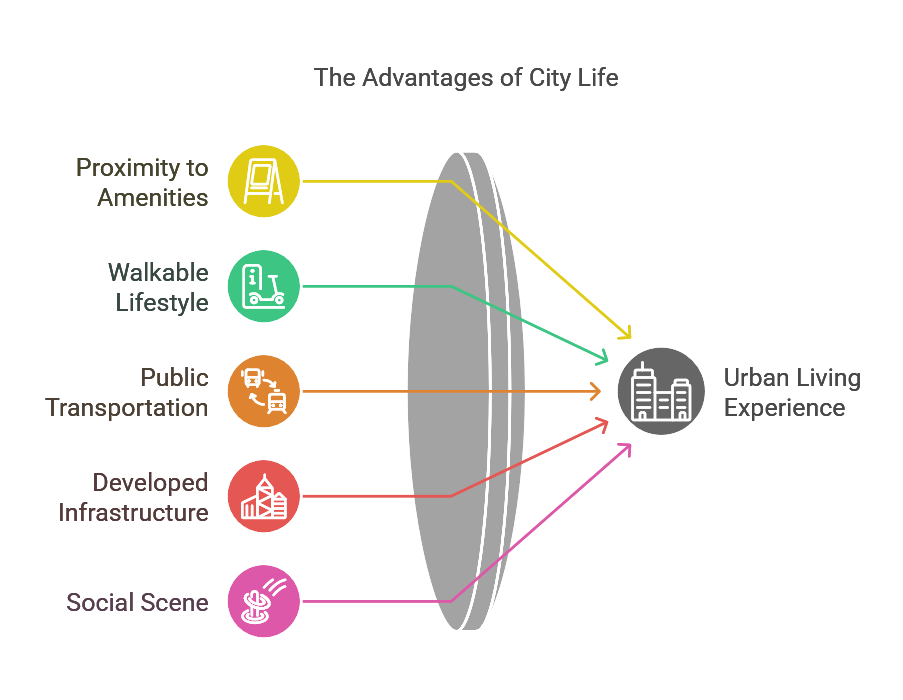
#1 – Live near the best the city has to offer
Central city areas are key urban centers where you’ll find most of the best shopping, entertainment and dining, as well as major infrastructure such as baseball, football, and hockey stadiums. These urban areas are also the most culturally vibrant and eclectic, making it hard to deny just how convenient and exciting it can be when living an urban lifestyle.
Urban dwellers have ample access to a full range of amenities and services close to home, sometimes even within walking distance. This includes annual festivals and celebrations of all sorts!
#2 – Enjoy a walkable lifestyle
If you work in or near the city centre, living in an urban community means you could walk to and from work or use public transit and leave the car at home.
You’ll save huge money on expenses such as parking, gas and other costs associated with using a motor vehicle. As we’ve previously mentioned, living, working, and playing all close to your urban home will provide you with more time in life to do the things you please.
#3 – Best access to public transportation
Municipalities almost always have centralized transportation hubs that branch out to other parts of the city. Therefore, living an urban over suburban lifestyle means you’ll have ample access to the best public transportation your city has to offer.
This may be an important aspect of choosing where to live if you don’t have access to a vehicle, but with most choices in life, there may be a trade-off with respect to the cost of your rent or mortgage versus living in a suburban home.
#4 – Better developed infrastructure
As cities become larger and increase population density to their urban areas, the infrastructure usually improves as well. This means you’ll be closer to public transit railways, pedestrian walkways, recreation centres, schools, post-secondary institutions, stadiums, and other critical city infrastructure of the sort.
If you truly want to live, work, and play where all the action is in your city, then it’s a given that choosing to live in an urban home versus a suburban home might be best for you.
#5 – More active social scene
If you’re looking to engage in daily activities and events in and around your community, an urban location is likely a better choice. That’s because cities often have their best sports, entertainment, and cultural activities and events located centrally where the appropriate infrastructure supports them.
Therefore, young professionals, for example, often choose to live centrally in a city so that they can take advantage of all the social events offered close to home.
Top 5 Cons of Urban Living
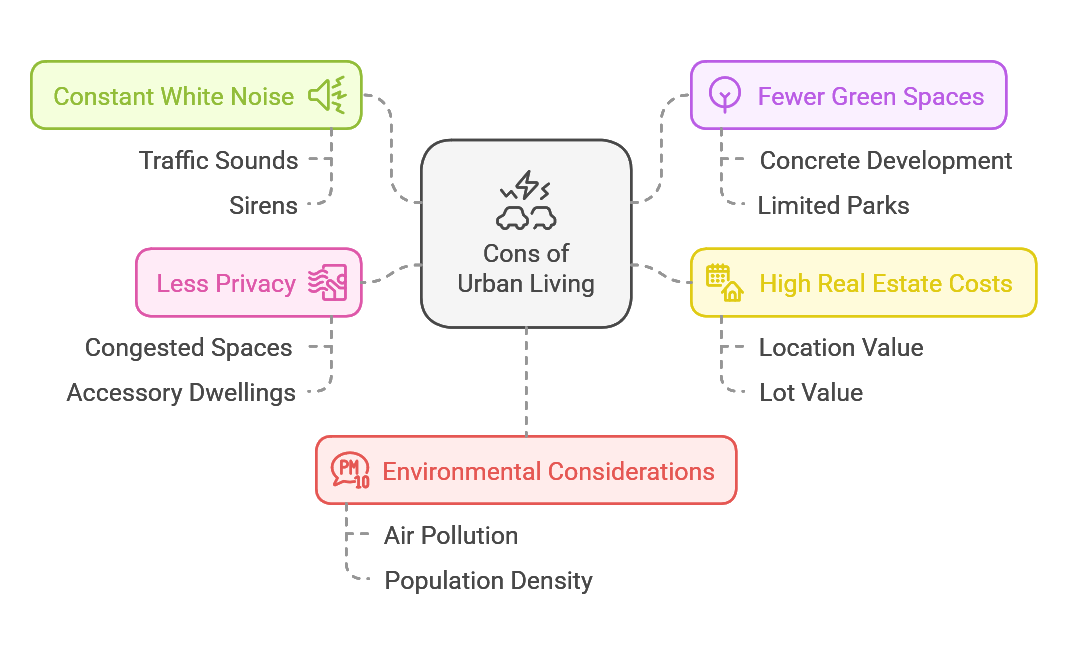
#1 – Constant white noise
Urban white noise is always a drag when you desire a relatively quiet and peaceful setting to live in. This comes in the form of motor vehicles whizzing by, police and ambulance sirens, and that general low background humming noise of any big city.
If you are the type who prefers to be away from people, nightlife and traffic, then you should definitely consider moving to a suburban or rural community.
#2 – Fewer green spaces and parks
Urban areas typically have fewer open park spaces for children to play in outside areas due to the development of large concrete buildings across the landscape. This results in central areas almost always having very few green spaces and parks to enjoy.
Many new mixed-use developments in places like Calgary and other major urban centres have turned a corner to focus on improving the amount of park space in central communities. However, they are still a long shot away from what’s offered by suburbia.
#3 – Real estate costs more on a comparative basis
Undoubtedly, there are higher costs associated with buying an urban property that is comparable to a suburban one for several reasons, including but not limited to location, lot value, and overall desirability.
Hence, the amount of living/outdoor space you would get for the same amount of money in an inner city, or downtown location will almost always be less than in a suburban area when comparing similar properties with similar features.
#4 – Less privacy between homeowners
Living spaces can sometimes feel congested in the inner city and downtown. There’s less space for your backyard trampoline, garden, and shed, and there might be more neighbour windows in viewing range vs. in a suburban area.
Urban homeowners must accept that a few extra windows might be peering into their yard space from adjacent homes. Additionally, the renaissance towards accessory dwelling construction like garage suites can mean even more density and less privacy for your family.
#5 – Environmental considerations
When considering where to move, urban and suburban areas are often evaluated on an environmental basis. As this becomes increasingly important for individuals, you’ll have to consider if an urban area suites your health and lifestyle goals.
Due to their central location, urban areas may have more air and environmental pollution due to more population density. If you’re looking to escape this altogether, rural areas to live would be your best bet.
Questions about Suburban vs. Urban Areas?
Whether you’re drawn to the vibrant urban lifestyle of Calgary’s downtown or the spacious tranquility of suburban communities, each choice has unique advantages.
Not sure which lifestyle is right for you? Contact the Calgaryism Real Estate Team today for expert guidance on finding your perfect home in the Calgary Metropolitan Area, whether it’s a downtown condo or a suburban family house, and we will be happy to assist you!
Required fields are marked*
- Airdrie
- Alberta
- Arts and Culture
- Blog
- Buying Tips
- Calgary
- Calgary Activities and Events
- Calgary Communities
- Calgary Condo Guide
- Calgary Infill Homes
- Calgary Luxury Homes
- Calgary New Condo Guide
- Calgary New Homes
- Calgary Real Estate Statistics
- Calgary Restaurants
- Calgary Townhomes
- Canada
- Condo Building Review
- Condos in Calgary
- Featured Blog Posts
- Featured Blogs
- First Time Home Buyers Guide
- Listings
- Moving to Calgary
- New Condo Projects
- Oil and Gas
- Selling Tips
- Slider
- Testimonials
- The Best in Calgary
- Uncategorized
- Video Testimonials
- Contact Us
- Search MLS®
- Sellers’ Guide
- Buyers’ Guide
- About Cody & Jordan
- Blog
- Testimonials
- Downtown Calgary
- SW Calgary
- SE Calgary
- NE Calgary
- NW Calgary
- Calgary Condos
- Calgary Townhomes
- Calgary Infills
- Calgary Luxury Homes
- New Calgary Homes
- New Calgary Condos
- Acreages for Sale
- Bungalows for Sale
- Duplexes for Sale



